Welcome to our complete guide on fountain pen ink cartridges. This guide will cover everything you need to know about these cartridges, from types to compatibility and even maintenance tips.
Knowing about ink cartridges is vital for any fountain pen user – it helps your pen work at its best, adds a personal touch to your writing, and lets you avoid problems like leaks.
So, let’s dive in and equip you to make intelligent choices about fountain pen ink cartridges.
Table of Contents
- 1. Understanding the Role of Ink Cartridges in Fountain Pens
- 2. Weighing the Pros and Cons of Using Ink Cartridges
- 3. Types of Fountain Pen Ink Cartridges
- 4. Types of Fountain Pen Inks Used in Fountain Pens
- 4.1. Dye-based Inks: The Classic Option
- 4.2. Pigment-based Inks: Stability Over Time
- 4.3. Iron-Gall Inks: Historic Durability
- 4.4. Bulletproof Inks: Security and Permanence
- 4.5. Shimmer Inks: Sparkle and Shine
- 4.6. Scented Inks: A Sensory Experience
- 5. Factors to Consider When Choosing Fountain Pen Ink Cartridges
- 6. Ink Cartridge Compatibility Guide
- 6.1. Short Standard International Fountain Pen Ink Cartridges
- 6.2. Propriety Fountain Pen Ink Cartridges
- 7. How to Refill a Fountain Pen Ink Cartridge with Bottled Ink
- 8. Ink Converters: Expanding Your Ink Choices
- 9. Preserving Your Fountain Pen: Tips for Cartridge Maintenance and Care
- 9.1. Correctly Inserting and Removing Cartridges
- 9.2. Cleaning Your Fountain Pen
- 9.3. Storage Tips to Prolong Cartridge Life
- 10. Top 5 Short International Size Fountain Pen Ink Cartridges
- 11. Conclusion
1. Understanding the Role of Ink Cartridges in Fountain Pens
An ink cartridge is the heart of a fountain pen, responsible for supplying the ink that makes these instruments so beloved by writing enthusiasts.
Functionally, it’s a small, replaceable component filled with liquid ink designed to fit into the pen barrel.
When inserted correctly, the ink flows smoothly from the cartridge through the pen’s feed to the nib, enabling it to write.
The design and function of ink cartridges vary, and they play a pivotal role in shaping the writing experience.
From the color and consistency of the ink to the cartridge’s lifespan, these elements can significantly impact your fountain pen’s performance and user experience.
2. Weighing the Pros and Cons of Using Ink Cartridges
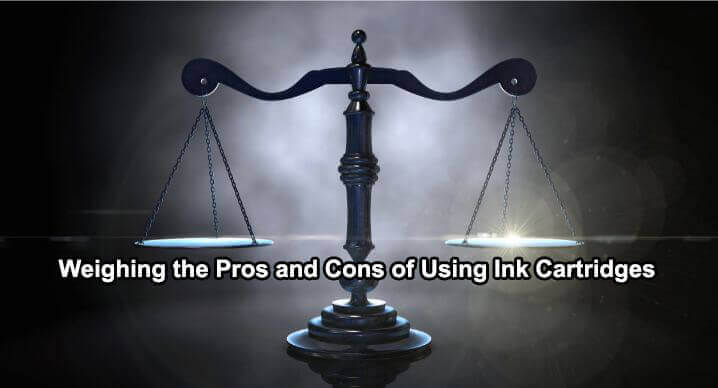
Ink cartridges present advantages and disadvantages, largely dependent on your writing habits, preferences, and fountain pen usage.
On the upside, ink cartridges are convenient and user-friendly, making them a preferred choice for beginners or those who prioritize simplicity.
They are easy to install and replace, come pre-filled with ink, and typically don’t create a mess.
This convenience extends to their portability, as you can carry extra cartridges for quick changes.
However, cartridges also have limitations.
They offer less variety than bottled ink in color options and properties (like wetness, shading, and sheen).
Cartridges may also prove less economical in the long run as they cost more per milliliter of ink than bottled ink.
Additionally, the compatibility issue can pose a challenge, as not all cartridges fit all fountain pens, requiring users to often stick with proprietary cartridges designed for their specific pen brand.
3. Types of Fountain Pen Ink Cartridges
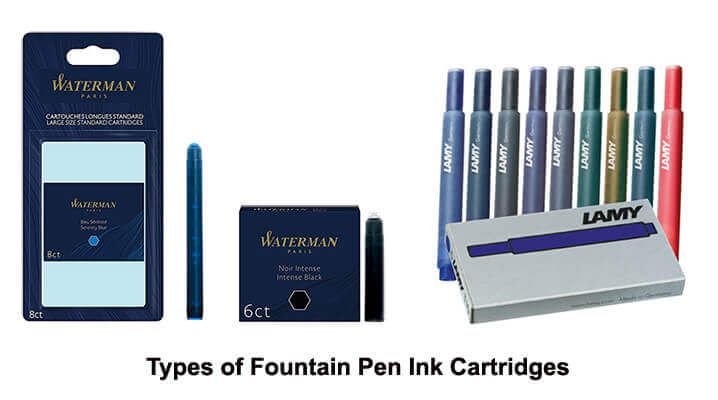
In fountain pens, not all ink cartridges are created equal. Two main types to consider are proprietary ink cartridges and standard international cartridges.
Understanding their unique features and compatibilities is crucial for anyone new to fountain pens and seeking to maximize their experience.
3.1. Proprietary Ink Cartridges
Fountain pen manufacturers specifically design proprietary ink cartridges to fit only their particular brand of pens.
This exclusivity often ensures optimal performance but may limit users’ ink choices and lead to slightly higher costs.
Examples of brands that employ proprietary cartridges include Pilot, Lamy, and Parker. Each brand has a unique cartridge design incompatible with other brands’ pens.
3.2. Standard International Cartridges: Short and Long Variants
Standard International Cartridges are famous for their broad compatibility. They come in two types: short and long.
The shorter ones, just 38mm long, carry about 0.8 ml of ink, while the longer ones, measuring 73mm, hold nearly twice as much.
Depending on the barrel length, most fountain pens can use both types.
Although short cartridges are more common, brands like Waterman and Pelikan make long cartridges for those who prefer a higher ink capacity.
Brands like Kaweco, Diplomat, and Faber Castell typically use shorter cartridges. Their versatility makes these cartridges a favorite among fountain pen enthusiasts.
4. Types of Fountain Pen Inks Used in Fountain Pens
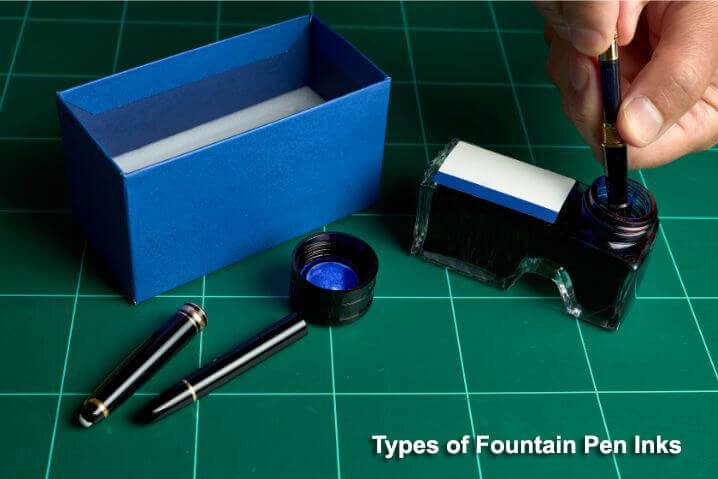
One size does not fit all when it comes to fountain pen inks.
The type of ink you choose can influence your writing style and the longevity of your work.
This section delves into the specifics of six major ink types typically found in cartridges: dye-based inks, pigment-based inks, iron-gall inks, bulletproof inks, shimmer inks, and scented inks.
By understanding the characteristics and uses of each, you can make an informed choice that caters to your writing needs and preferences.
4.1. Dye-based Inks: The Classic Option
Dye-based inks are the traditional choice for fountain pen cartridges. These inks are soluble, meaning the colorant dissolves entirely in water.
The result is a smooth flow and a vibrant range of colors.
However, dye-based inks are less permanent and may fade over time or when exposed to water and light.
4.2. Pigment-based Inks: Stability Over Time
Pigment-based inks differ from dye-based ones because they use tiny, insoluble particles to provide color.
While they offer excellent water resistance and lightfastness, they can be prone to clogging in some fountain pens due to their particle content.
The Japanese brands Platinum and Sailor make two of the most well-known pigment inks.
Artists favored the Platinum Carbon ink for its high water resistance and deep black color and Sailor Sou Boku for its excellent waterproof, quick drying, and color-fast properties.
If you use pigment-based inks, you must clean the pen regularly.
4.3. Iron-Gall Inks: Historic Durability
Iron-gall inks have a history dating back to the Middle Ages. They are made from tannins and iron salts, creating an ink that darkens as it oxidizes over time.
They are known for their permanence and resistance to water and light. Iron-gall inks are an excellent choice for archival writing.
However, they can be corrosive to some pen materials and require diligent maintenance.
4.4. Bulletproof Inks: Security and Permanence
Developed by Noodler’s Ink Company, bulletproof inks resist solvents, bleach, and light, making them virtually permanent.
They bond with the paper, making them an excellent choice for documents that must remain legible for a long time.
While safe for use in most fountain pens, they may require more frequent cleaning due to their unique formulation.
4.5. Shimmer Inks: Sparkle and Shine
Shimmer inks, primarily produced by J. Herbin and Diamine, bring glamour to the fountain pen world.
Their unique formulation features minute glitter particles suspended in ink, adding a radiant sparkle to your writing when put to paper.
However, these suspended particles may clog the pen’s feed over time, necessitating regular pen maintenance to ensure a smooth writing experience.
4.6. Scented Inks: A Sensory Experience
Scented inks, produced by leading brands like De Atramentis, Diamine, and Jacques Herbin, introduce a unique dimension to fountain pen writing.
These inks, infused with various fragrances, deliver a captivating multisensory experience. However, the oils used for these fragrances may not agree with every fountain pen, potentially affecting performance.
Frequently cleaning your pen is highly recommended when using these aromatic inks.
5. Factors to Consider When Choosing Fountain Pen Ink Cartridges
Several factors come into play when selecting ink cartridges for your fountain pen.
These considerations range from the compatibility of the cartridge with your pen, drying time, and waterproofness, to the color saturation and wetness of the ink.
Additionally, the availability and cost of the ink can also play a critical role in your decision-making process.
Compatibility with Your Fountain Pen
The first consideration when choosing an ink cartridge is your fountain pen type. Not all cartridges fit all pens.
For example, some pens work exclusively with proprietary cartridges from the same brand, while others accept the more universally compatible Standard International Cartridges.
Always verify that the cartridges you’re interested in are compatible with your pen to avoid disappointment or damage.
Drying Time
The drying time of ink can significantly impact your writing experience. If you’re a fast writer, left-handed, or often use your pen for quick notes, an ink that dries quickly may be vital to preventing smudging.
However, fast-drying inks may also lead to quicker clogging, requiring more frequent cleaning of your pen.
Waterproofness
Depending on your needs, you might want an ink that can withstand exposure to water. Inks vary in water resistance; some, like pigment-based and iron-gall inks, offer high waterproofness.
This feature is particularly crucial if you’re using your pen for artwork or documents that need longevity.
Color Saturation
Color saturation refers to the intensity and richness of the ink’s color.
Consider cartridges with high color saturation if you prefer bold, vibrant writing or drawing.
However, remember that highly saturated inks might take longer to dry and require more regular pen maintenance.
Wetness of the Ink
The “wetness” of an ink refers to its flow properties. Wet inks flow more freely from the pen, creating a smoother writing experience and often a darker line.
However, they can also increase the drying time and bleed-through on certain paper types.
On the other hand, dry inks are less prone to bleed through and dry quicker, but they might not provide the same level of smoothness when writing.
Availability and Price
Finally, consider the ink’s availability and price. While some exotic or specialty inks might be enticing, they can be expensive and harder to find.
When selecting an ink, consider its cost-effectiveness and whether it’s readily available when you need a refill.
6. Ink Cartridge Compatibility Guide
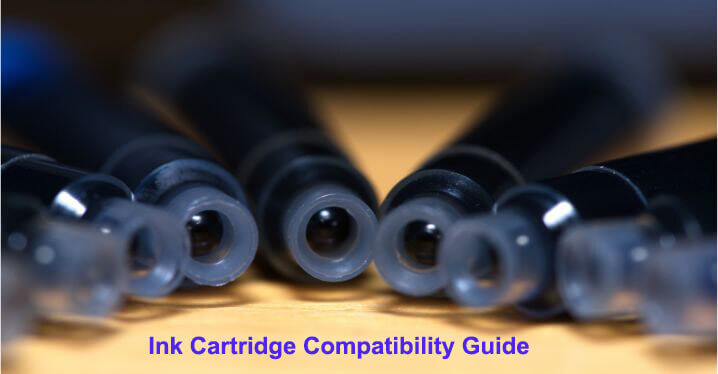
Ink cartridge compatibility is a critical factor to consider in fountain pens. Not all cartridges fit all pens, with the main culprits being the differences in the design, shape, and size of cartridges across brands.
6.1. Short Standard International Fountain Pen Ink Cartridges
The following brands all make and use short international-sized cartridges in their fountain pens
- Bexley
- Caran d’Ache
- Cartier
- Conklin
- Conway Stewart
- Daniel Hechter
- Delta
- Diplomat
- Edison
- Elysee
- Esterbrook
- Faber Castell
- Franklin Covey
- Graf von Faber Castell
- Grifos
- J Herbin
- Jörg Hysek
- Kaweco
- Laban
- Lalex
- Manuscript
- Messenger (WH Smith)
- Midori/Traveler’s Company
- Montblanc*
- Montegrappa
- Monteverde
- Nettuno
- ONLINE
- Onoto
- Pelikan
- Recife
- Retro 51
- Rotring
- Senator
- Sensa
- Sigma
- ST Dupont (exceptions apply)
- Stipula
- Tombow
- Traveler’s Company
- TWSBI
- Visconti
- Waldmann
- Waterman (exceptions apply)
- Yard-O-Led
*Note: There may be exceptions within the brand for Montblanc and ST Dupont. Always check with the manufacturer or seller for the specific model you are considering.
6.2. Propriety Fountain Pen Ink Cartridges
Certain brands opt for proprietary ink cartridges designed exclusively for their specific models. Here are some brands known to use proprietary ink cartridges:
- Aurora
- Cross
- Lamy
- Montblanc
- Namiki
- Parker
- Penbbs
- Pilot
- Platinum
- Sailor
- Sheaffer
7. How to Refill a Fountain Pen Ink Cartridge with Bottled Ink
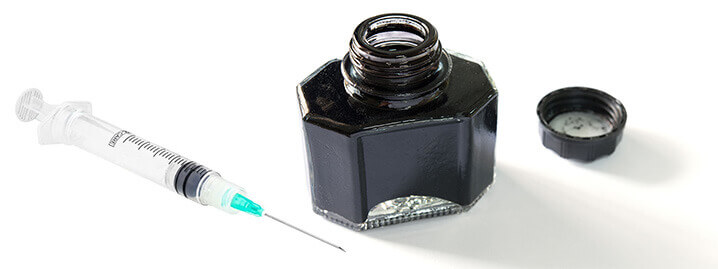
You can use a vast range of bottled inks to refill a fountain pen when you have an ink converter.
However, sometimes you don’t have a converter and want to refill a fountain pen ink cartridge with a particular type of ink.
Filling an ink cartridge with bottled ink is an economical and environmentally friendly way to use fountain pens. Here are the steps you should follow:
- Preparation: Start by ensuring your workspace is clean and distraction-free. I recommended laying down a protective layer (like a plastic sheet or old newspapers) to avoid any potential ink spills.
- Cleaning the Cartridge: If you’re reusing an old cartridge, ensure it’s thoroughly cleaned. Rinse it with water to remove any residual ink and allow it to dry completely. Any leftover old ink may interact negatively with the new ink.
- Filling the Syringe: Draw ink into the syringe from your ink bottle. Be sure to draw up only enough to fill your cartridge.
- Injecting the Ink: Insert the syringe into the end of the cartridge that goes into the nib and slowly release the ink. Fill the cartridge up to about 80% of its capacity to avoid overflowing when you insert it back into the pen.
- Reinserting the Cartridge: Insert the refilled cartridge back into your pen. Be sure it’s firmly in place.
- Clean Up: Clean your syringe thoroughly with water. Keeping your ink syringe clean is crucial to prevent cross-contamination between different inks.
- Priming the Pen: If the pen doesn’t start writing immediately, you might need to prime it by gently squeezing the cartridge until some ink seeps into the feed.
Remember, always use ink intended for fountain pens. Using the wrong ink can damage your pen. It’s also good practice to clean your fountain pen regularly to maintain its performance and longevity.
8. Ink Converters: Expanding Your Ink Choices
Ink converters are handy tools for using bottled inks in your fountain pen instead of cartridges.
They’re like reusable ink cartridges that you can fill up again and again with any ink you like.
Using an ink converter, you can explore a world of ink colors and types beyond what’s available in cartridges for your specific pen.
Plus, they can help solve compatibility problems. If your pen only takes a specific brand’s cartridges, using the correct ink converter means you can use any bottled ink you want.
It’s a simple way to unlock many possibilities with your fountain pen.
9. Preserving Your Fountain Pen: Tips for Cartridge Maintenance and Care
9.1. Correctly Inserting and Removing Cartridges
When it comes to maintaining the quality of your fountain pen, the first step is understanding how to insert and remove ink cartridges properly.
It can prevent potential damage and ink leaks.
To insert a new cartridge, unscrew the pen’s body to reveal the section where the cartridge fits.
Gently push the narrow end of the cartridge into the pen until you feel it pop into place.
To remove it, reverse the process, ensuring you pull it out gently to avoid any unnecessary spillage.
9.2. Cleaning Your Fountain Pen
Routine cleaning of your fountain pen is crucial in maintaining its performance and longevity. Over time, ink residue can accumulate in the nib and feed, resulting in clogging and poor ink flow.
To clean your fountain pen, disassemble it and soak its parts in a cup of lukewarm water until it runs clear.
You may need to rinse and repeat several times for thorough cleaning. Once clean, leave the parts to dry naturally before reassembling the pen.
9.3. Storage Tips to Prolong Cartridge Life
Proper storage of your fountain pen and its cartridges can significantly extend its lifespan.
Store your pen upright with the nib pointed upwards when not in use to prevent the ink from drying out.
If you plan to store the pen for a prolonged period without use, removing the ink cartridge and keeping it separately in a cool, dark place to preserve the ink’s quality is best.
Also, remember to cap your pen after every use to prevent the nib from drying out, which can affect your pen’s writing performance.
10. Top 5 Short International Size Fountain Pen Ink Cartridges
- Diamine: Diamine stands out as a top choice for international ink cartridges, boasting the most extensive selection with a spectrum of 40 colors. Their high-quality ink provides a consistent, smooth writing experience.
- Kaweco: Fountain pen enthusiasts respect Kaweco cartridges for their color depth, vibrancy, and excellent ink flow.
- J. Herbin: This historic French company offers a rich palette of colors in their international-size cartridges. They are renowned for their unique, special edition inks, J. Herbin cartridges are perfect for those seeking something different.
- Pelikan: A reliable choice for many fountain pen enthusiasts, Pelikan’s international cartridges are widely respected for their consistent performance and variety of classic ink colors.
- Waterman: Waterman cartridges are renowned for their excellent flow and vibrant, steadfast colors. Their international-size cartridges are highly reliable and compatible with many fountain pen brands.
11. Conclusion
Navigating the different types of fountain pen ink cartridges can initially seem overwhelming. Still, with a deeper understanding of their types, features, and functions, you are now well-equipped to make an informed choice.
Whether proprietary or standard international cartridges, dye-based or shimmer inks, each offers a unique writing experience.
From considering factors like the type of pen you have, drying time, waterproofness, and color saturation to understanding compatibility issues and ways to address them, this guide has equipped you with all the necessary information.
Let’s not forget the importance of proper maintenance and care of your fountain pen to ensure a prolonged cartridge life.
With renowned brands like Diamine, Kaweco, Waterman, J.Herbin, and Pelikan offering top-quality ink cartridges, you can experiment with various hues and styles to find your preference.
Remember, the choice of an ink cartridge significantly influences your fountain pen experience. Choose wisely and let your pen glide smoothly, translating your thoughts onto paper with the perfect ink flow.
So, here’s to enhancing your writing journey with the correct fountain pen ink cartridges!
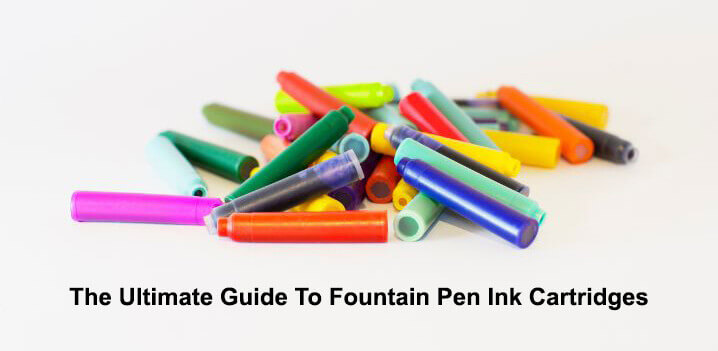
It seems some standard cartridges have a 2.6 bore and some a 3.4 bore (Diamine?).
How does one know what goes with a specific pen?